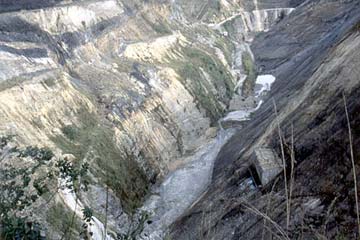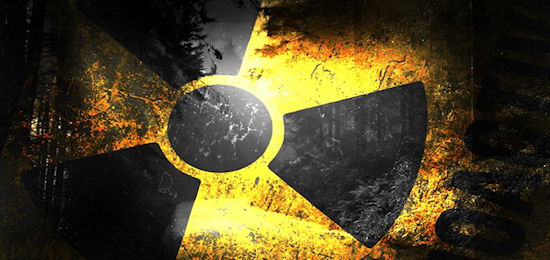In the beginning of the 1970’s, a strange discovery created a sensation.
A load of uranium that was intended for the French nuclear industry, was found to have a content in 235U , the fissionable isotope of uranium, smaller than expected. This discovery led to a series of assumptions ranging from fears for theft of fissionable material by some unknown country or organization to scenarios of UFO involvement, or confirmation of the existence of an advanced ancient civilization. However the truth was still more impressive.
Operation of nuclear reactors
The uranium is present in the nature constituted from three major isotopes, in fixed proportions:
238U in proportion 99.274%
235U in proportion 0.720%
234U in proportion 0.005%
This isotopic constitution is considered fixed for all uranium deposits found on earth. From the three isotopes, the only one that can sustain a chain reaction is the 235U . Most reactors use uranium which has been treated, in order to raise his content in 235U up to 3%, percentage necessary for a fission reaction to begin and be sustained.
The fission of 235U atoms produces neutrons which are carriers of large quantities of energy. The reaction is sustained only when the number of neutrons produced by the reaction is equal to the number of neutrons that are absorbed by other atoms (fission by-products) or escape from the core. However beyond the conservation that of balance, the neutrons must also be slowed down, because the fission reaction is more efficient with low energy neutrons. This is achieved with the use of water or graphite (mainly in the reactors that are used for the production of plutonium), as moderator. The moderator also serves as a neutrons reflector, thus decreasing the number of neutrons that escape from the core.
Chain reactions are not induced in the natural uranium deposits, even in the presence of water, or when they are dissolved in water, because of their low content in 235U . Nevertheless reactors of heavy water, like the Canadian CANDU, or combination of heavy water and graphite, like the Russian RBMK, can achieve chain reaction, even with not enriched uranium. In any case most reactors use enriched uranium (3-5% 235U), while nuclear reactors that have been placed in submarines and other warships have been reported to use uranium with degree of enrichment up to 90%. Enriched uranium is usually used with the form of an oxide (UO2).
As it has already been mentioned, during a chain reaction, part of the neutrons released are absorbed by other atoms and form by-products (pe production of plutonium – 239Pu from 238U atoms ). Some of these by-products are also fissionable and hence contribute in the chain reaction. However most of them, having big neutrons absorption cross-sections simply absorb neutrons and poison the reactor fuel. The accumulation of these by-products leads, in combination with the reduction the 235U because of the fission reaction, in the exhaustion of fuel and the loss of criticality, resulting to reactor shut-down. For this is also the reason the reactor fuel has to be, periodically replaced.
The Oklo phenomenon
The uranium that was transported in France in 1972 and in which a decreased proportion of 235U was observed, emanated from deposits at Oklo, in Gabon Africa. When it was realised that the percentage of 235U was smaller than the expected 0.72%, the first thought was that somebody they had removed the fissionable isotope, or had replaced the load of natural uranium with the spent fuel of a nuclear reactor. But even more exotic theories were and are still presented and supported. Oklo became the likely crash point of an UFO and the uranium that was found there was the fuel of the reactor that powered the UFO. For others, the Oklo uranium deposit was simply the nuclear waste dump site of an ancient, advanced civilization. The geological surveys that were carried out in the area, led to an explanation less fascinating, but equally interesting.
About 3.5 billions years ago, the geological structure and composition of the planet was very different from the one we know today. The isotopic constitution of natural uranium was characterized by the presence of 235U in a percentage of about 33%. According to the above mentioned details of a fission reaction mechanics, this composition is more than capable for a chain reaction to commence. However the enrichment in 235U does not suffice for a chain reaction to self-sustain, without the presence of a moderator. The uranium has the attribute of being soluble in water only in the presence of oxygen and under his form of oxides. At that time, the atmosphere’s oxygen did not suffice for the uranium tobe dissolved in water.
2 billions years later the conditions were much different. The content of atmosphere in oxygen and hence the oxygen dissolved in water had been increased, while the 235U levels in natural uranium it had been decreased to about 3%. It is roughly the same period that the evolution of the first aerobic life forms takes place. In areas with natural uranium deposits, uranium oxides water solutions were formed. These solutions were on the order of a few ppm ( parts per million ).
A solution like that, under the form of a flowing stream, appeared in Oklo. Along the stream, a certain type of algae was growing and these microorganisms were selectively accumulating uranium oxide. The result was certain sites of high uranium oxide concentration, containing roughly 3% of 235U, in the presence of water. Actually the general configuration of today’s nuclear reactors. When the deposition of uranium oxide was enough to constitute a critical mass, a fission reaction began. The water functioned as a moderator and reflector of neutrons, while when the reaction was getting “out of control” the energy released caused an increase of water boiling and hence increase of its evaporation, removing part of the moderating and reflecting capability of the configuration, leading to slowing-down of the reaction. In the Oklo area, a series of about 17 natural reactor sites were developed and it appears that they remained active for a few million years, operating in energy levels on the order of 1 Kw.
 |
Further researches showed that the content in 235U in the deposits of the area, varies from 0.4 to 0.7%. It is estimated that the sites of higher concentration (0.7%) are the sites where the nuclear waste was deposited because 239Pu, produced as a by-product, reverts back to 235U in relatively short time (its half-life period is “only” 2.4 x 104 years while the 235 U half-life period is 7.13 x 108). Some traces of thorium and other nuclides were also found. Finally it was observed that the areas with the larger uranium deposits were also the ones with the smaller percentages of the fissionable isotope, precisely as one would have expected in the case of a nuclear reactor.
The final conclusion is that in the Oklo area, a number of natural nuclear reactors operated and based on the isotopes and by-products half life data this happened about 1.7 billion years ago. Similar observations (decreased percentages of 235U) were made in other uranium deposits, as in Colorado, USA. It appears therefore that the Oklo phenomenon was not unique.
Even if this explanation rather is disappointing for the mystery and unknown fans it is exceptionally important, mainly for two reasons.
The first one is rather theoretical. The existence of natural nuclear reactors and hence the creation in the nature of elements like the plutonium, displaces uranium from its place as the heavier of the periodic table. Also, one of the most important, but also more controversial, developments of the 20th century is proved to be a copy of a purely natural process.
The second reason has enormous practical value. The careful and analytic examination of the areas where natural nuclear reactors operated, and the course of evolution of the ecosystems there, in adjacency with accumulated nuclear waste, can lead to very useful conclusions on the management of nuclear waste that is produced today. Perhaps finally the technological solutions for the treatment of quantities of spent fuel, may result through the advice and the experience of nature.





